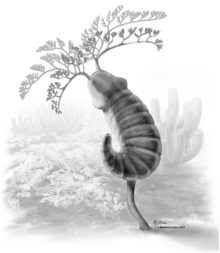Cambroernid
The cambroernids are an unranked clade of deuterosome animals. They include a number of early Paleozoic genera whose affinities with other animals, living or extinct, have been uncertain ('bizarre" or "orphan" taxa). This includes Herpetogaster (the type genus) and Phlogites, as well as the eldoniids (including the Cambrian Eldonia ludwigi from the Burgess Shale of Canada, Stellostomites eumorphus, Rotadiscus grandis, and Pararotadiscus guizhouensis from southwest China, and Seputus pomeroii from the Ordovician of Ireland[1]). Cambroernids are defined by a set of common features including at least one pair of bifurcated or divided oral tentacles, and a large stomach and narrower intestine enclosed together in a coiled sac. The proposed evolutionary transformation is from more mobile forms living in the water column to less mobile forms living on the sea floor. Herpetogaster shows a clockwise-curved body attached to the substrate with a narrow mobile stolon, the caylx of Phlogites would be such a body fused into a complete circle, permanently attached to the substrate by a thick stalk, and eldoniids are a flattened form in which the stolon has been lost, resulting in a disc-shaped external form with a large curved stomach on one side. These translations of form are parallel to those seen in echinoderms (such as crinoids, sea urchins, sand dollars). Relationships to tentaculate lophotrochozoans are considered and rejected, with the balance of evidence currently supporting the clade as either stem echinoderms, stem hemichordates, or stem ambulacrarians (echinoderms+hemichordates).[2]
| Cambroernida | |
|---|---|
 | |
| Herpetogaster | |
| Scientific classification | |
| Kingdom: | Animalia |
| Stem group: | Ambulacraria |
| Clade: | †Cambroernida |
| Subdivisions | |
| |
References
- MacGABHANN, BREANDÁN ANRAOI; MURRAY, JOHN (2010). "NON-MINERALISED DISCOIDAL FOSSILS FROM THE ORDOVICIAN BARDAHESSIAGH FORMATION, CO. TYRONE, IRELAND". Irish Journal of Earth Sciences. 28: 1–12. doi:10.3318/IJES.2010.28.1. hdl:10395/2407. JSTOR 25780702.
- Caron, J.; Conway Morris, S.; Shu, D.; Soares, D. (2010). Soares, Daphne (ed.). "Tentaculate fossils from the Cambrian of Canada (British Columbia) and China (Yunnan) interpreted as primitive deuterostomes". PLoS ONE. 5 (3): e9586. doi:10.1371/journal.pone.0009586. PMC 2833208. PMID 20221405.